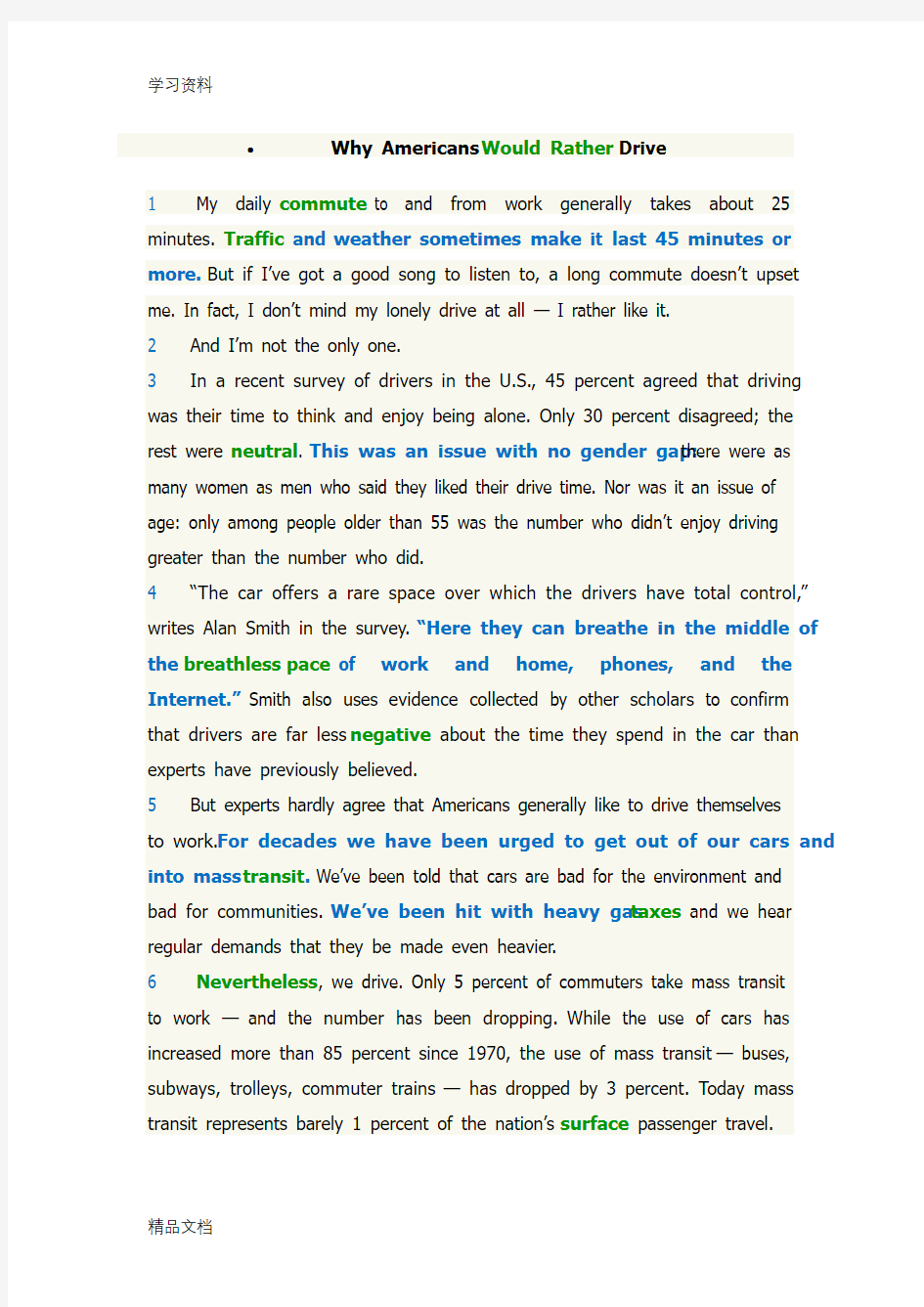最新新标准高职实用综合教程(第2版)第四册-unit3翻译培训资料

- 1、下载文档前请自行甄别文档内容的完整性,平台不提供额外的编辑、内容补充、找答案等附加服务。
- 2、"仅部分预览"的文档,不可在线预览部分如存在完整性等问题,可反馈申请退款(可完整预览的文档不适用该条件!)。
- 3、如文档侵犯您的权益,请联系客服反馈,我们会尽快为您处理(人工客服工作时间:9:00-18:30)。
•Why Americans Would Rather Drive
1 My daily commute to and from work generally takes about 25 minutes. Traffic and weather sometimes make it last 45 minutes or more.But if I’ve got a good song to listen to, a long commute doesn’t upset me. In fact, I don’t mind my lonely drive at all — I rather like it.
2 And I’m not the only one.
3 In a recent survey of drivers in the U.S., 45 percent agreed that driving was their time to think and enjoy being alone. Only 30 percent disagreed; the rest were neutral. This was an issue with no gender gap: there were as many women as men who said they liked their drive time. Nor was it an issue of age: only among people older than 55 was the number who didn’t enjoy driving greater than the number who did.
4 “The car offers a rare space over which the drivers have total control,” writes Alan Smith in the survey. “Here they can breathe in the middle of the breathless pace of work and home, phones, and the Internet.” Smith also uses evidence collected by other scholars to confirm that drivers are far less negative about the time they spend in the car than experts have previously believed.
5 But experts hardly agree that Americans generally like to drive themselves to work.For decades we have been urged to get out of our cars and into mass transit.We’ve been told that cars are bad for the environment and bad for communities. We’ve been hit with heavy gas taxes and we hear regular demands that they be made even heavier.
6 Nevertheless, we drive. Only 5 percent of commuters take mass transit to work —and the number has been dropping. While the use of cars has increased more than 85 percent since 1970, the use of mass transit — buses, subways, trolleys, commuter trains — has dropped by 3 percent. Today mass tr ansit represents barely 1 percent of the nation’s surface passenger travel.
7 Almost without exception, every time a city builds or expands a subway system, the percentage of commuters using public transit decreases. At a cost of more than $10 billion, Washington D.C. built a large subway network in the 1970s and 1980s. It now carries a smaller proportion of the region’s commuters than the old bus and trolley system did 30 years ago.
8 It is not that Americans wouldn’t listen to their experts, but i t is reasonable to prefer private cars to public trains and buses. Cars and highways are available 24 hours a day. They go almost everywhere. They sharply reduce travel time — in America, the average mass transit commute takes 42 minutes while the average commuter driving to work makes it in only 20. And without question, cars and highways are safer: death rates are much lower for cars and highways — especially interstate highways — than for most forms of mass transit.
9 It isn’t a “love affair” with c ars that keeps Americans behind the wheel. It is the freedom, flexibility, and efficiency that automobiles provide. Nor is this an American phenomenon. Anywhere people have the choice, they choose to drive.In Europe, automobile use has risen steadily for decades. Since 1989, in what was East Germany, the number of people using mass transit has been reduced by 50 percent; the number using cars now equals that in the former West Germany.
10 People who dislike cars need to face the reality: Americans would rather drive. Subways and commuter trains, no matter how much is spent on them, will account for only a small proportion of commuter trips. We have far more mass transit than we need, but not nearly enough highway lanes. So it is high time to start spending the money where it is most needed.
•我每天上下班花在路上的时间大约为25分钟,有时由于交通和天气的原因,要花45分钟甚至更长的时间。但如果有一首好歌听着,在路上待久一点也并不让我感到心烦。事实上,我一点都不反感独自驾车,我很喜欢这样呢。
• 2 而且,喜欢驾车上下班的并非我一人。
